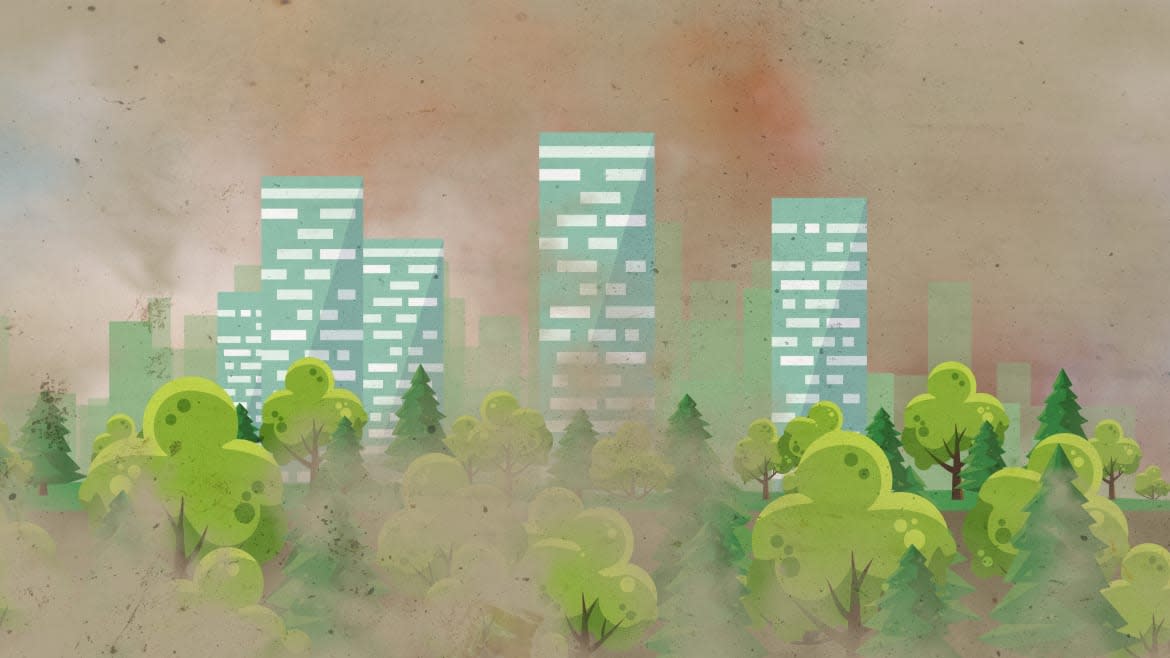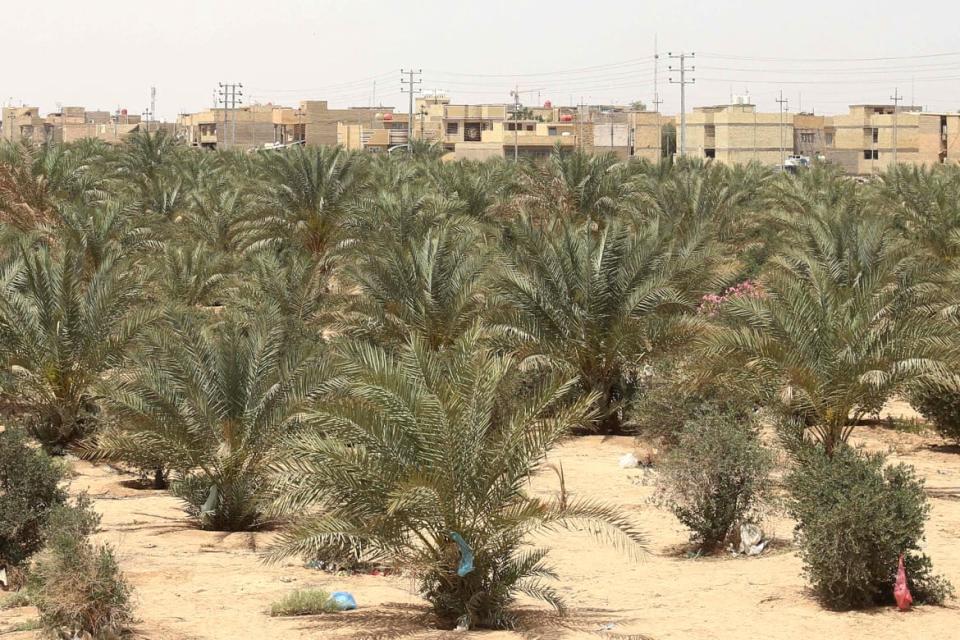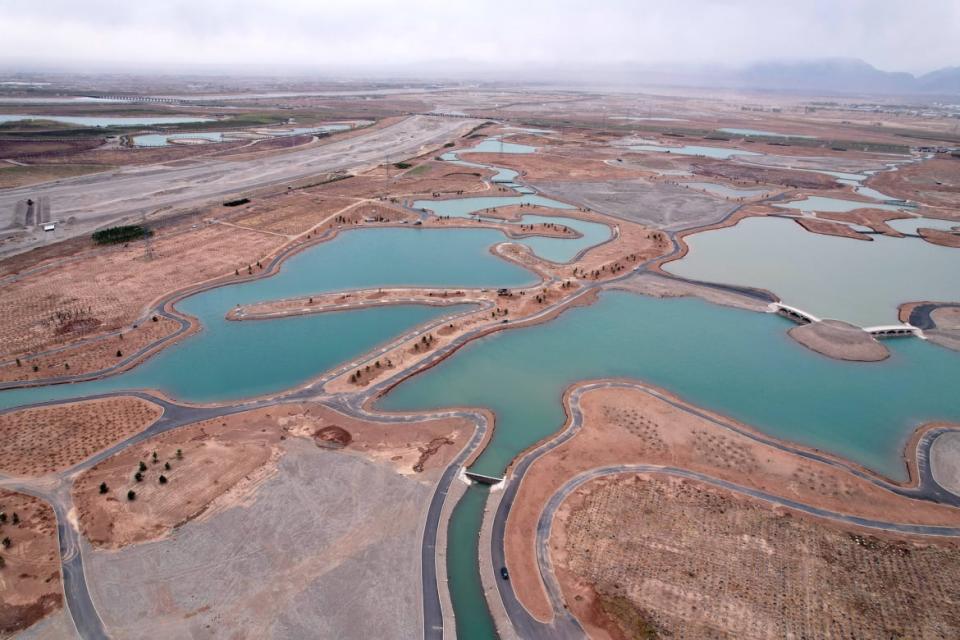How Huge Tree Walls Help Stop a Growing ‘Mad Max’ Hellscape for Desert Cities

Outside the city of Karbala in central Iraq, a roughly 330-foot-wide wall of date palms and olive trees sways in the dust. Its northern axis reaches far around the city in a 16 mile-long arc. Its southern axis stretches a further 13 miles.
The trees haven’t always been there. This natural windbreak was first proposed as a measure to protect the city’s 576,000 inhabitants in 2006. Dust storms that sweep across Iraq every year cause havoc on the streets and send thousands to hospital with breathing difficulties. Some even kill. Karbala’s wall of trees was intended both to calm the storms and to filter minuscule particles of dust from the air.
Such green belts have become more popular as countries in arid regions struggle with increasing dust storms. Global warming and ineffective water management have increased drought by almost a third in some areas since 2000. Drought, in turn, raises the chances of strong winds collecting sand and dust particles on their way towards inhabited areas. The Iraqi government expects the country to experience 272 days of dust annually over the next 20 years.
Addressing the cause of the issue—climate change—requires global effort. But protective windbreak structures like the one around Karbala present a possible band-aid solution. One such belt of trees around an urban area in Dubai was able to reduce airborne dust by up to 22 percent.
“If they’re tall trees, they will absorb some of the dust in the atmosphere as it passes over,” Nick Middleton, a fellow in physical geography at the University of Oxford, told The Daily Beast. “It will get deposited on leaves and, therefore, not in the area that you're supposedly protecting. You can use it as a sort of barrier for the dust itself.”
The tree walls help communities in other ways too. They improve air quality by acting as CO2 sinks, cool the surrounding atmosphere, provide new environments for animals to live in, and their construction brings money and jobs to low-income communities. But they’re also riddled with challenges.
Green belts require massive funding to cover the cost of labor and the trees themselves. With Karbala’s green belt and others, those large budgets might prove too attractive for corrupted officials in some states. “You might have a big pot of money,” Middleton said. “But if someone diverts it for other things, then it's not serving its purpose.”
In fact, engineers were never able to finish the original 47-mile plantation in the Iraqi city. Around 16 billion dinars ($11 million) were set aside for the massive project. Only nine billion ($6 million) ever made it, according to one former Karbala councilor.

Palm and olive grove in the "green belt" area of Iraq's central city of Karbala, on April 18, 2022.
Even with access to the necessary funding, the tree walls require enormous effort to maintain. China’s nearly 2,800 mile “Great Green Wall” was planted to prevent the expansion of the Gobi Desert, the world’s fastest growing desert that gobbles up 2,237 miles of grassland each year. But a lack of water has consistently hampered efforts, and only 15 percent of planted trees have survived since the start of the project.
Ali Al-Dousari, a senior research scientist at the Kuwait Institute for Scientific Research, has helped to develop several such projects. He believes a more natural approach could improve chances of success. One of the main reasons the projects fail is due to their use of non-native plants, he said. These plants may require huge volumes of water because their roots are adapted to another environment. Native plants, on the other hand, will often thrive when planted in the same location.
“Native plants are the real solution for the future,” Al-Dousari told The Daily Beast. “The plants have the capability to catch the sand, use it, and to adapt to it and stabilize it.”
The positioning of the protective tree walls can also make a difference, he said. Previously desolate, desert areas might not provide the right environment for vegetation to survive. His home country Kuwait, for example, is attempting to grow a belt of trees near its desert border with Iraq—and he expects it to fail at a very high cost.

The progress of land greening in the Gobi Desert in Zhangye City, in China's northwest Gansu Province.
Green belts can even damage biodiversity. His research team noticed that the trees at one plantation they grew attracted high numbers of birds of prey including eagles and hawks. Existing populations of lizards, snakes, and foxes disappeared from the area soon after. Another plantation on a Kuwaiti island altered the migration pattern of a rare species of bird that had once laid its eggs in the area.
“The ecosystem changed as a whole,” he said. “You, as a human being, are the most dangerous species damaging the system by putting in solutions which are not compatible with that environment.”
Encouraging growth in areas where vegetation might otherwise thrive, would present the best way forward, Al-Dousari said. His analysis discovered that organic matter like seeds and pollen makes up about 5 percent of particles swept up in dust storms. Growing plantations along the routes that dust storms follow might provide a solution that maintains itself.
Middleton believes success might be found closer to the source of dust storms. “Once the stuff is in the air, it's more difficult to protect yourself,” he said. “It might be the case that you'd be spending your time and money more effectively by finding out wherever it’s originally coming from.”
Al-Dousari completed a tour of southern Iraq in January 2019 to take dust samples at different sites along the Euphrates river. He discovered two specific hotspots where up to a third of all dust blowing into Kuwait originates. He’s now attempting to collaborate with Iraq’s agricultural ministry to stabilize dust in the source areas.
“We are not doing research for the purpose of research,” he said. “We are trying to help about 40 million people affected by those two hot spots. And not only the 40 million, but also the new generations coming.”
Got a tip? Send it to The Daily Beast here
Get the Daily Beast's biggest scoops and scandals delivered right to your inbox. Sign up now.
Stay informed and gain unlimited access to the Daily Beast's unmatched reporting. Subscribe now.
